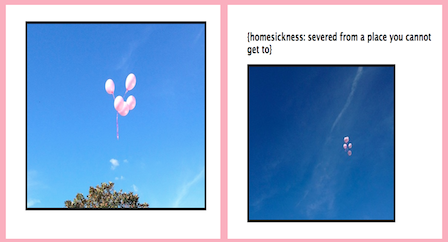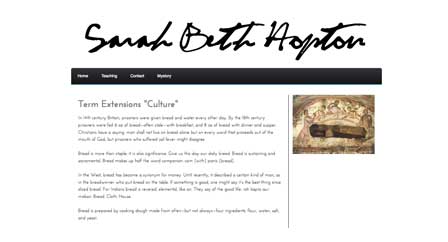Our [Electrate] Stories
Explicating Ulmer's Mystory Genre
Marc C. Santos, Ella R. Bieze, Lauren E. Cagle, Jason C., Zachary P. Dixon, Kristen N. Gay, Sarah Beth Hopton, Megan M. McIntyre
1. What work does the mystory do?
“The goal of the mystory, to use Nietzsche's phrase, is ‘to find that secret point at which the aphorism of thought intersects with the anecdote of life’” (Ulmer, 2005, p. 21).
In order to understand the work of the mystory, participants explicated their understanding of electracy; these understandings by and large echo and expand the explication offered in this webtext's discussion of electracy. For instance, Kristen N. Gay suggested that the form of the mystory—the order of the discourses (from career to family to entertainment to community) and the emphasis on imagistic reasoning—relied on and reinforced the values of electracy: “Ulmer's project in Internet invention (2003) instigated a personal unfolding and a shift from a literate person ‘reason[ing] on paper’ to ‘an electrate person feel[ing] online’ (145).” Zachary P. Dixon noted how the mystory highlights the “limitations of traditional literacy and its inability to fully account for the possibilities enabled in digital multimodality”; but electracy “can help illustrate the possibilities for both future cultural production and change.” Jason Carabelli suggested that these possibilities are better supported in electracy because of its rejection of traditional conceptions of logos, which aren't “robust enough to characterize the dynamic rhetorical activity of electracy, where the personal meets the civic and rhetorical in generating meaning online.” Instead, he wrote, electracy relies on “emotion in its model of reasoning. That is to say, in electracy, images, sounds, moods, and feelings are an integral part of reasoning (see, for instance, C.’s Wide Emblem exercise, which attempts to capture the mood of the mystory process in an interactive emblem).”
As previously noted, Gregory L. Ulmer offered Roland Barthes’ concept of the punctum as a way of describing the connections between affect, image, and electracy. As Lauren E. Cagle described it, “the mystory explores the possibilities for electracy by pushing us to create new ways of ordering and presenting information that rely not on step-by-step logic, but on images which can produce a punctum, ‘that which stings or pricks one emotionally’ (Ulmer, 2003, p. 44).” Carabelli also highlighted the centrality of the punctum to the work of the mystory: “For Ulmer, the mystory is a recording of the punctum, the obtuse meanings, of one’s relationship to the four discourses. These emotional ‘stings’ are the personal notions of learning and inventing that are accidental in literacy, but fundamental in electracy.” The “sting” is metaphorical, but no less real for it. Gay aptly described the sting of the punctum as “resid[ing] in the conflicting feelings that give us pause.” Emotional response, personal feeling, is clearly a cornerstone of the mystory. Dixon described the construction of the mystory as a process in which “images are selected and arranged in deeply personal and expressive ways.”
This deeply personal work of the mystory is addressed by multiple participants. In practice, the intersection between the possibilities opened by electrate practices and the punctum produced by the mystory’s visual and multimedia content often occurred through personal reflection and remembrance, at times linked to self-discovery. For example, Cagle described how her reflections on places she has lived led to awareness of “a pervasive concern with the state of being in-between and away from. This in-betweenness became clear when I created my Mapping Home page, in which long pink triangles criss-cross the Atlantic Ocean, much like I did many times as a child.” Ella R. Bieze offered an interpretation of what the reflections do:
I think the work that a mystory actually does is allow the person creating the mystory to reflect, remember, and refract the different experiences, interactions, dreams, and moments that have shaped them into the person they are at the time they create their mystory. In this way, the work of the mystory is personal and, I would argue, inherently intimate.
This intimacy stems from the often difficult or buried experiences Ulmer asks us to uncover; as Bieze put it, the mystory “gives us an opportunity to dig into the raw wounds we've let scab over as time has passed.” (Such digging might be seen in Gay’s “Haiku” or Megan M. McIntyre’s "Obtuse Meanings"). McIntyre agreed that the mystory’s work calls for personal reflection and sometimes painful remembrance, but suggests that personal does not necessarily mean individual or private:
after composing a mystory, it’s difficult to argue that I’m a wholly rational, autonomous subject; instead, I’m revealed as a compilation of memories and forces, at least partially dependent on others for my identity and agency. In short, I’m not sure there’s any such thing as a mystory or individual agency; I’m always already part of some "we."
For Ulmer, this process of self-discovery acts as a precursor to civic and communal action. As McIntyre noted, “Ulmer’s call for us to trace our histories seems particularly potent in view of his goal of self-discovery.” This term, “self-discovery,” however, is problematic; McIntyre argued that for Ulmer self-discovery doesn’t mean coming “to know some essential self.” Rather, the mystory asked us to “trace the forces that shape us and in doing so, discover our (always multiple) selves” (McIntyre). Gay explained that the mystory’s introspective uncovering process “prepare[s] us for ethical inter/action [which] springs from valuing personal, embodied, and subjective experiences as the starting point for understanding ourselves and listening to others.” In her reflection, Gay described her favorite part of her mystory:
My favorite part of my mystory is the Decision Scene page. I created this page that asked me to present a metaphor for the way I make decisions as I started to apply to Ph.D. programs. The uncertainty of this process led me to think of surrender and releasing control as ways to make decisions, and this immediately made me think of releasing balloons into the air. (What is more uncertain than releasing balloons to the sky?)
As I went to buy balloons from the cashier, he asked me how many I wanted. The one balloon seemed sort of sad by itself, so I asked for five. I took them to my backyard and released them slowly, watching them fade away until I could not see them anymore. I could not tell if they had gone on or dissolved. But I found it strangely comforting to know that all five balloons were tethered together. Seeing the balloons floating so far away made me think of the feeling of homesickness. The balloons could not get back and I could not bring them back; their release was permanent.
This is my favorite page on my mystory because it is nostalgic for me—remembering the uncertainty of that period of time that led me to perform this project in this way. It reminds me that while I may not have absolute control over decisions I make, I also never make decisions in isolation. It reminds me that sometimes making decisions does not mean controlling the outcome, but opening a possibility.
Metaphorically, composing a mystory functions as a way to excavate our most foundational actions, motives, and dispositions so that these kinds of seemingly unlikely connections reveal themselves and (hopefully) alter the way we solve problems. Or as Gay put it, “Ulmer’s mystory...works to prepare egents for political and ethical action in virtual spaces.” McIntyre agreed:
Though Ulmer’s goal in Internet Invention isn’t communal, he notes, in Electronic Monuments, that electracy is meant "to do for the community what literacy did for individuals," to send the community "to school collectively" (xxvi). The mystory is the first step toward our collective electrate education.
Or, to put it another way, “We write to learn, to wrestle with the tropes that define us, perhaps to tell stories anew, and then to manifest change in the world” (Sara Beth Hopton).





